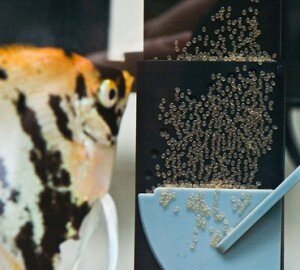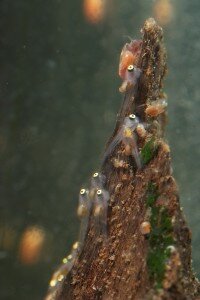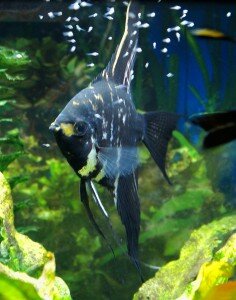The common freshwater angelfish, Pterophyllum scarlare, are so easy to breed that you may find yourself as an accidental angelfish breeder when you suddenly spot a pile of eggs in your tank. If your angelfish have started a family without help from you, this information and tips will help you help the parents continue to care for their eggs and fry. Although once you’ve ventured into angelfish breeding, you may find yourself hooked.
Males vs. Female Angelfish
To positively identify that you have a male and female pair of angelfish with complete accuracy, you will need to produce live fry. And then you may still not know which one is the male and which is the female without close observation throughout the day. Sexing angelfish is difficult even for experienced angelfish breeders, as the males and females will look alike and even have similar behaviors. However, there are some general characteristics in adult angelfish to look for that can help you determine if you have a potential breeding pair of angelfish.
Common Male Angelfish Characteristics:
- May develop a nuchal hump, a small lump on the forehead near the nose
- More territorial
- Papilla (breeding organ) is more pointed. You will only see the papilla, located near the anal fin, emerge when the eggs have been laid and the male is preparing to fertilize the eggs.
- Fertilizes the eggs by passing over the laid eggs and releasing sperm. If you see this, you have a confirmed male.
Common Female Angelfish Characteristics:
- Less territorial
- Papilla (the breeding organ near the anal fin) is wider
- Can see eggs in the papilla before laying
- May see her lay the eggs
Breeding & Raising Anglefish will teach you everything you need to know about breeding and raising angelfish fry. You can buy it here on Amazon.
You Got Angelfish Eggs! Now What?
If you are not planning to raise hundreds of angelfish into adults, there’s not much you need to do, as nature will help you out. You can leave the eggs and let the parents do their job. However, don’t be surprised if the parents eat their first batch or two of eggs. Angelfish seem to learn parenting by trial and error. Parents that eat the first batch may let their second batch of eggs hatch and then eat the fry. By the third or fourth try, your angelfish breeders may develop into nurturing, attentive, and protective parents.
Letting the parents and nature take over is fascinating to watch. The angelfish will lay their eggs on a flat usually horizontal surface such as a broad leaf. They will diligently clean the leaf prior to laying and fertilizing the eggs. Attentive angelfish breeder parents will hover over the eggs and chase off intruding fish. If you have a community tank, watch to ensure this is not causing too much stress for the other fish. The eggs will hatch within 7 days. Within 48 hours, you should be able to see the fry moving inside the eggs. If the eggs are white, they are not fertile or have a fugal or bacterial infection that killed the egg.
The Angelfish Eggs Disappeared!
If you had eggs before going to bed, but woke up to a tank without a trace of eggs, don’t worry yet. While it is possible that the parents ate the eggs, or let other fish eat the eggs, take a close look around the tank. Attentive angelfish parents will often move the eggs. Look at other flat surfaces, both vertical and horizontal, for the wiggling eggs. You may find them stuck to the heater or sides of the tank. If you are not sure where to look, watch the parents’ to see if they are hovering over and protecting a certain area of the tank. If they are still acting protective, then there are eggs or fry to protect.
About seven days after laying the eggs, the fry will be developed and very little of the egg will be left. But they won’t go swimming about for several more days. They will still cling to where their parents placed them. And if any fall, the parents will scoop them up in their mouth and put them back. At this point you need to start providing food for your angelfish fry. Feed them baby brine shrimp, which you can buy frozen, or a commercial fry food such as First Bites, Fry Starter Formula, or Liquifry several times a day. At about three to six weeks after hatching, the angelfish fry will be large enough to eat your regular fish food. 500 Freshwater Aquarium Fish also states that the fry will “feed on body mucus (“milk”) secreted by the parents.” Until they are about nine months old, feed foods that have at least 50 percent protein content.
The Parents are Eating the Fry! Now What?
Once the fry are swimming about the tank, you may notice the parents gobbling the fry up. Before becoming disappointed in your adult angelfish’s parenting skills, watch the tank for several minutes. Attentive angelfish parents will collect their wandering fry in their mouth, swim back to the fry corner of the tank, and spit them all out. It’s their way of herding the babies and keeping them safe.
Helping Angelfish Fry Survive in a Community Tank
Life is dangerous for angelfish fry growing up in a community tank. Most, if not all, will get eaten by bigger fish. If you’d like a few fry to survive, there are things you can so to help angelfish fry survive in a community tank. When you see the eggs, plant tall plants that will give the fry space to hide in, such as anacharis, Camboda, or hornwort. Add décor or rocks that are tall and have tiny spaces that fry can enter but larger fish cannot. The fry spend much of their time in the upper half of the tank, so this is the area to provide protection. When the fry are swimming around feed the tank large and baby brine shrimp several times a day. This will give the other fish in the community tank something live to eat other than the fry.
Try Try Again
If this batch didn’t make it, you’re likely to be trying again in as little as two to four weeks. If you want to let nature take its course and hope for a couple of survivors, then all you need to do is enjoy watching nature in your home aquarium. However, if you’ve now got an interest in serious angelfish breeding, then you’ll need to have a less hazardous fish tank set up for the next batch of angelfish eggs.




